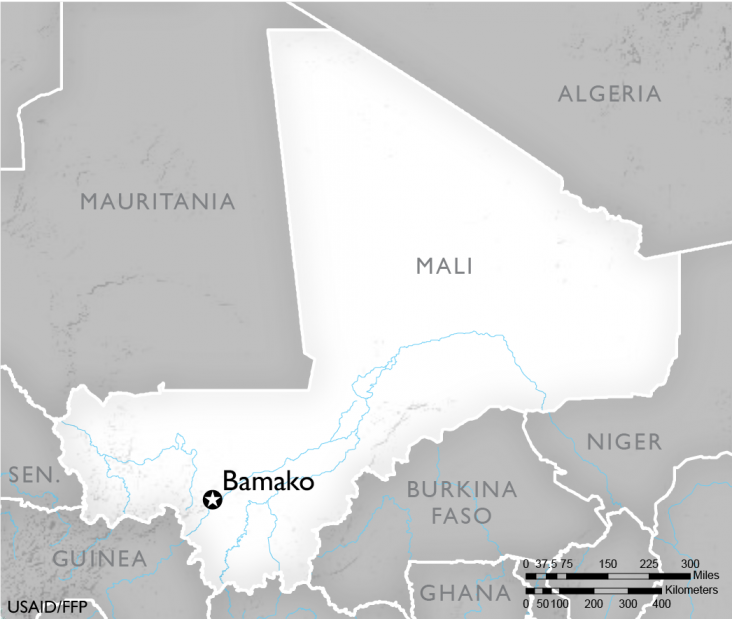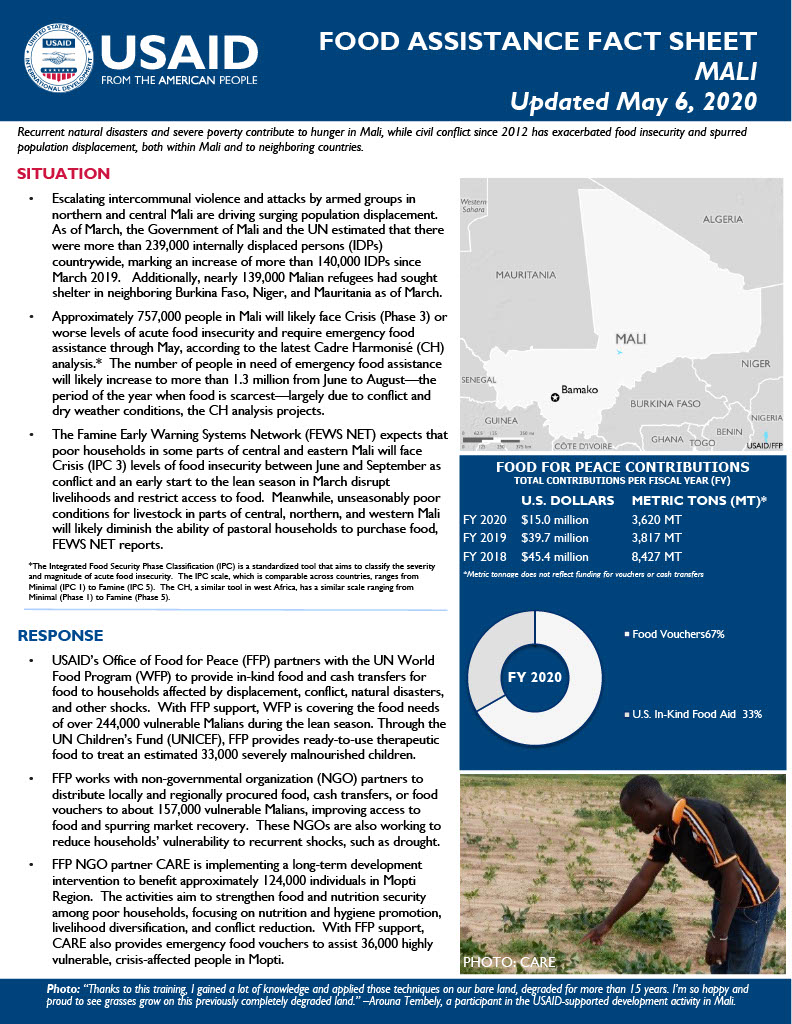Home » What We Do » Agriculture and Food Security » Food Assistance » Where We Work » Food Assistance Fact Sheet - Mali
- What We Do
- Agriculture and Food Security
- Democracy, Human Rights and Governance
- Economic Growth and Trade
- Education
- Environment and Global Climate Change
- Gender Equality and Women's Empowerment
- Global Health
- Humanitarian Assistance
- Transformation at USAID
- Water and Sanitation
- Working in Crises and Conflict
- U.S. Global Development Lab
Speeches Shim

May 6, 2020
Recurrent natural disasters and severe poverty contribute to hunger in Mali, while civil conflict since 2012 has exacerbated food insecurity and spurred population displacement, both within Mali and to neighboring countries.
Situation
- Escalating intercommunal violence and attacks by armed groups in northern and central Mali are driving surging population displacement. As of March, the Government of Mali and the UN estimated that there were more than 239,000 internally displaced persons (IDPs) countrywide, marking an increase of more than 140,000 IDPs since March 2019. Additionally, nearly 139,000 Malian refugees had sought shelter in neighboring Burkina Faso, Niger, and Mauritania as of March.
- Approximately 757,000 people in Mali will likely face Crisis (Phase 3) or worse levels of acute food insecurity and require emergency food assistance through May, according to the latest Cadre Harmonisé (CH) analysis.* The number of people in need of emergency food assistance will likely increase to more than 1.3 million from June to August—the period of the year when food is scarcest—largely due to conflict and dry weather conditions, the CH analysis projects.
- The Famine Early Warning Systems Network (FEWS NET) expects that poor households in some parts of central and eastern Mali will face Crisis (IPC 3) levels of food insecurity between June and September as conflict and an early start to the lean season in March disrupt livelihoods and restrict access to food. Meanwhile, unseasonably poor conditions for livestock in parts of central, northern, and western Mali will likely diminish the ability of pastoral households to purchase food, FEWS NET reports.
* The Integrated Food Security Phase Classification (IPC) is a standardized tool that aims to classify the severity and magnitude of food insecurity. The IPC scale, comparable across countries, ranges from Minimal (IPC 1) to Famine (IPC 5). The CH, a similar tool used only in West Africa, has a separate scale ranging from Minimal (Phase 1) to Famine (Phase 5).
Food Assistance Fact Sheet - Mali ![]() (pdf - 251k)
(pdf - 251k)
Response
- USAID’s Office of Food for Peace (FFP) partners with the UN World Food Program (WFP) to provide in-kind food and cash transfers for food to households affected by displacement, conflict, natural disasters, and other shocks. With FFP support, WFP is covering the food needs of over 244,000 vulnerable Malians during the lean season. Through the UN Children’s Fund (UNICEF), FFP provides ready-to-use therapeutic food to treat an estimated 33,000 severely malnourished children.
- FFP works with non-governmental organization (NGO) partners to distribute locally and regionally procured food, cash transfers, or food vouchers to about 157,000 vulnerable Malians, improving access to food and spurring market recovery. These NGOs are also working to reduce households’ vulnerability to recurrent shocks, such as drought.
- FFP NGO partner CARE is implementing a long-term development intervention to benefit approximately 124,000 individuals in Mopti Region. The activities aim to strengthen food and nutrition security among poor households, focusing on nutrition and hygiene promotion, livelihood diversification, and conflict reduction. With FFP support, CARE also provides emergency food vouchers to assist 36,000 highly vulnerable, crisis-affected people in Mopti.
Food for Peace Contributions
Total Contributions:
| U.S. Dollars | Metric Tons | |
|---|---|---|
| Fiscal Year 2020 | $15.0 million | 3,620 MT |
| Fiscal Year 2019 | $39.7 million | 3,817 MT |
| Fiscal Year 2018 | $45.4 million | 8,427 MT |
* Metric tonnage does not reflect funding for vouchers or cash transfers.
Country Specific Information
Related Resources


Comment
Make a general inquiry or suggest an improvement.